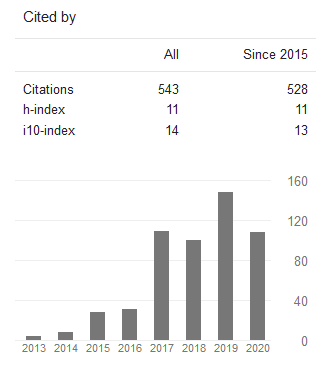Machine Learning for Environmental Health: Optimizing ConcaveLSTM for Air Quality Prediction
DOI:
https://doi.org/10.24002/jbi.v15i1.8707Keywords:
air quality prediction, ConcaveLSTM model, parameter optimization, temporal dependencies, environmental modelling, prediksi kualitas udara, optimasi parameter, dependensi temporal, pemodelan lingkungan, model ConcaveLSTMAbstract
This study investigates the optimization of the ConcaveLSTM model for air quality prediction, focusing on the interplay between input sequence lengths and the number of LSTM units to enhance forecasting accuracy. Through the evaluation of various model configurations against performance metrics such as RMSE, MAE, MAPE, and R-squared, an optimal setup featuring 50 input steps and 300 neurons was identified, demonstrating superior predictive capabilities. The findings underscore the critical role of model parameter tuning in capturing temporal dependencies within environmental data. Despite limitations related to dataset representativeness and environmental variability, the research provides a solid foundation for future advancements in predictive environmental modeling. Recommendations include expanding dataset diversity, exploring hybrid models, and implementing real-time data integration to improve model generalizability and applicability in real-world scenarios.
References
“A Study of Environmental Impact of Air Pollution on Human Health: Pm Deposition Modelling,” Global Nest Journal, 2023, doi: 10.30955/gnj.004613.
S. K. Maji, S. Ahmed, M. Kaur-Sidhu, S. Mor, and K. Ravindra, “Health Risks of Major Air Pollutants, Their Drivers and Mitigation Strategies: A Review,” Air Soil and Water Research, 2023, doi: 10.1177/11786221231154659.
I. M. Tănasă, M. M. Cazacu, and B. Sluser, “Air Quality Integrated Assessment: Environmental Impacts, Risks and Human Health Hazards,” Applied Sciences, 2023, doi: 10.3390/app13021222.
L. Šulc, P. Gregor, J. Kalina, O. Mikeš, T. Janoš, and P. Čupr, “City-Scale Assessment of Long-Term Air Quality Impacts on the Respiratory and Cardiovascular Health,” Frontiers in Public Health, 2022, doi: 10.3389/fpubh.2022.1006536.
R. Singh, R. Jakhar, R. Raj, and P. Sachar, “A Comprehensive Study on Impacts of Air Pollution on Environment and Human Health,” International Journal of Recent Technology and Engineering, 2022, doi: 10.35940/ijrte.a6976.0511122.
S. Sui and Q. Han, “Multi-View Multi-Task Spatiotemporal Graph Convolutional Network for Air Quality Prediction,” The Science of the Total Environment, 2023, doi: 10.1016/j.scitotenv.2023.164699.
V. Singh, K. K. Singh, and S. H. Singh, “A Secure and Energy-Efficient Framework for Air Quality Prediction Using Smart Sensors and ISHO-DCNN,” International Journal of Sensors Wireless Communications and Control, 2023, doi: 10.2174/2210327913666230504122805.
G. Cican, A.-N. Buturache, and R. Mirea, “Applying Machine Learning Techniques in Air Quality Prediction—A Bucharest City Case Study,” Sustainability, 2023, doi: 10.3390/su15118445.
V. K. Rani and R. Vallikannu, “Air Pollution Prediction Model for Estimating and Forecasting Particulate Matter PM2.5 Concentrations Using SOSE-RMLP Approach,” International Journal of Global Warming, 2023, doi: 10.1504/ijgw.2023.130128.
S. Coelho, J. Ferreira, D. F. Carvalho, and M. Lopes, “Health Impact Assessment of Air Pollution Under a Climate Change Scenario: Methodology and Case Study Application,” Sustainability, 2022, doi: 10.3390/su142114309.
E. X. Neo et al., “Towards Integrated Air Pollution Monitoring and Health Impact Assessment Using Federated Learning: A Systematic Review,” Frontiers in Public Health, 2022, doi: 10.3389/fpubh.2022.851553.
X. Deng et al., “Disease Specific Air Quality Health Index (AQHI) for Spatiotemporal Health Risk Assessment of Multi-Air Pollutants,” Environmental Research, 2023, doi: 10.1016/j.envres.2023.115943.
K. Kamboj and A. Mathur, “Air Quality Assessment With Human Health Effects for Kota Metropolis, Rajasthan India.,” Current World Environment, 2022, doi: 10.12944/cwe.17.2.10.
S. Ren, B. Guo, K. Li, Q. Wang, and Z. Yu, “CoupledGT: Coupled Geospatial-Temporal Data Modeling for Air Quality Prediction,” Acm Transactions on Knowledge Discovery From Data, 2023, doi: 10.1145/3604616.
F. Karimi, J. Amanollahi, M. Reisi, and M. Darand, “Prediction of Air Quality Using Vertical Atmospheric Condition and Developing Hybrid Models,” Advances in Space Research, 2023, doi: 10.1016/j.asr.2023.04.020.
S. Arifin et al., “Long Short-Term Memory (LSTM): Trends and Future Research Potential,” International Journal of Emerging Technology and Advanced Engineering, 2023, doi: 10.46338/ijetae0523_04.
Y. Liu and D. Wu, “Research on the Prediction of Short Time Series Based on EMD-LSTM,” Journal of Computational Methods in Sciences and Engineering, 2023, doi: 10.3233/jcm-226860.
X. Xiang and J. Zhou, “An Excess Entropy Approach to Classify Long-Term and Short-Term Memory Stationary Time Series,” Mathematics, 2023, doi: 10.3390/math11112448.
H. M. Nguyen et al., “Long Short-Term Memory Bayesian Neural Network for Air Pollution Forecast,” Ieee Access, 2023, doi: 10.1109/access.2023.3265725.
M. Gabriel and T. Auer, “LSTM Deep Learning Models for Virtual Sensing of Indoor Air Pollutants: A Feasible Alternative to Physical Sensors,” Buildings, 2023, doi: 10.3390/buildings13071684.
M. Teng et al., “72-Hour Real-Time Forecasting of Ambient PM2.5 by Hybrid Graph Deep Neural Network With Aggregated Neighborhood Spatiotemporal Information,” Environment International, 2023, doi: 10.1016/j.envint.2023.107971.
E. Ramentol, S. Grimm, M. Stinzendörfer, and A. Wagner, “Short-Term Air Pollution Forecasting Using Embeddings in Neural Networks,” Atmosphere, 2023, doi: 10.3390/atmos14020298.
Z. Zhang, H. Chen, and X. Huang, “Prediction of Air Quality Combining Wavelet Transform, DCCA Correlation Analysis and LSTM Model,” Applied Sciences, 2023, doi: 10.3390/app13052796.
K. Pan, J. Lü, J. Li, and Z. Xu, “A Hybrid Autoformer Network for Air Pollution Forecasting Based on External Factor Optimization,” Atmosphere, 2023, doi: 10.3390/atmos14050869.
C. Huang, X. Zhao, W. Cheng, Q. Ji, Q. Duan, and Y. Han, “Statistical Inference of Dynamic Conditional Generalized Pareto Distribution With Weather and Air Quality Factors,” Mathematics, 2022, doi: 10.3390/math10091433.
Y. Huang, B. Guo, H. Sun, H. Liu, and S. X. Chen, “Relative Importance of Meteorological Variables on Air Quality and Role of Boundary Layer Height,” Atmospheric Environment, 2021, doi: 10.1016/j.atmosenv.2021.118737.
X.-B. Jin et al., “Variational Bayesian Network With Information Interpretability Filtering for Air Quality Forecasting,” Mathematics, 2023, doi: 10.3390/math11040837.
T. Li et al., “Contributions of Various Driving Factors to Air Pollution Events: Interpretability Analysis From Machine Learning Perspective,” Environment International, 2023, doi: 10.1016/j.envint.2023.107861.
W. Huang, Y. Cao, X. Cheng, and Z. Guo, “Research on Air Quality Prediction Based on Improved Long Short-Term Memory Network Algorithm,” Peerj Computer Science, 2022, doi: 10.7717/peerj-cs.1187.
Downloads
Published
Issue
Section
License

This work is licensed under a Creative Commons Attribution-ShareAlike 4.0 International License.
Copyright of this journal is assigned to Jurnal Buana Informatika as the journal publisher by the knowledge of author, whilst the moral right of the publication belongs to author. Every printed and electronic publications are open access for educational purposes, research, and library. The editorial board is not responsible for copyright violation to the other than them aims mentioned before. The reproduction of any part of this journal (printed or online) will be allowed only with a written permission from Jurnal Buana Informatika.
This work is licensed under a Creative Commons Attribution-ShareAlike 4.0 International License.










